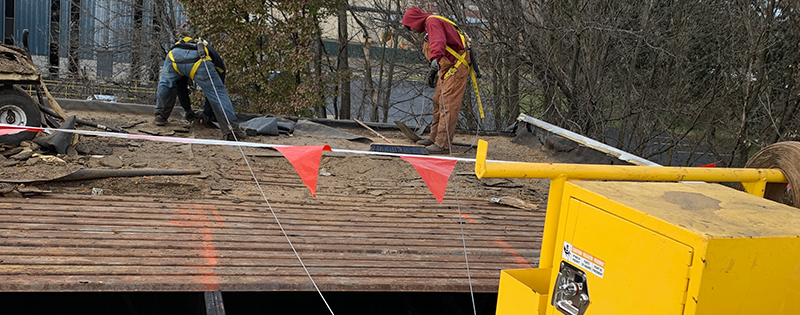A solid roof system is your building’s first line of defense against weather-related damage and potentially costly leaks. But even durable, well-maintained roofs eventually require new commercial roof installation.
There is a wide range of factors that can determine the timeline. This article will explore the elements that affect cost and overall timeline of roof installation.
Do I Need New Commercial Roof Installation?
There are two reasons that you would need commercial roof installation: to completely replace a damaged roof or to install your building’s first roof.
The first step is to determine if you need to repair or replace your roofing. Severe damage, poor insulation, water damage, damage from ponding water, and compromised roofing materials that are several years or decades old may require a complete roofing overhaul.
While the cost of replacing your roof may be significant as compared to roof repair, your company can benefit from long-term cost savings through increased energy efficiency. Business owners often seek commercial flat roof installation and other upgrades to improve the types of materials placed over a building.
When deciding whether to repair your existing roof or undertake a reroofing project, trust the advice of a reputable roofing contractor.
How Long Does Commercial Roof Installation Take?
This is a common question. Construction projects can be distracting for workers who have to deal with work-related noise and the continual hauling of construction materials. It’s safe to assume that crews will work as quickly as possible, but commercial roofing companies have to factor in these common variables for your roofing project when projecting timelines:
Type of Existing Roof Design
Roofs come in a surprisingly wide range of designs–TEMA has worked with businesses that need everything from commercial flat roof installation to intricate custom work…and everything in between! Roofs made of several sections, possibly at various heights, will generally require more time to replace. Roofs with complex design work will similarly take longer to construct.
The Commercial Building’s Square Footage
The square footage of your roof is likely the most significant factor that will determine how long your roof installation will take to complete. Of course, there’s no way to adjust this variable, so prepare to wait several weeks for your building to be fitted with a new roof if you own a large retail center, strip mall, or other major commercial building.
Construction Materials
The type of material used for your roof replacement will partly determine how long your project takes to complete. Although less common on commercial projects, shingles are one of the easier roofing materials to install. The timeline of your commercial roof installation will be partly determined by the material that your roof is made of.
The material base of your old roof will similarly add time to your construction timeline. Removing a metal roof takes longer than pulling shingles, for example. Although certain materials take longer to install, the benefits may well outweigh the addition of a week or two of construction time.
Other Commercial Roof Variables
Weather is a factor that affects pretty much anything in life. Icy or rainy weather could delay your construction timeline.
The size of your work crew is another significant factor. Your contractor will have a standard size crew, but that doesn’t mean those numbers aren’t adjustable — likely for an additional cost.
If your roof was blown off by a storm, safely removing those materials can delay construction. Once your commercial roof installation has started, any unexpected damage that is found could also delay your roof installation.
On average, roof replacement projects take anywhere from several days to four or five weeks.
What Are My Roofing Options?
As you can imagine, there is a wide range of roofs available. Here are some of the more commonly installed commercial roof options.
Metal Commercial Roofing
Metal roofing systems tend to be on the more expensive side but are highly durable. Metal roofs can be made from galvanized steel, copper, aluminum, zinc, and other metals.
Modified Bitumen Roofing
Mod-bit roofing, as it is sometimes known, is a commercial roofing system made from roof fabrics and bitumen. The materials are applied in layers and provide a high degree of stability and protection.
Thermoplastic Roofs (TPO)
Thermoplastic roofs are resistant to bacterial growth. The base plastic material also makes this a lightweight option. This type of roofing is commonly found in restaurants that release organic materials (cooking oils and smoke) from ventilation systems.
Green Roofing
This eco-friendly option has become increasingly popular in recent years. Green roofs are designed and made with materials that lower energy bills. Some roofing systems even accommodate plant growth on top!
Make the Most Out of Your Commercial Building’s New Roof
Warranties are great, but preventative steps to protect your roof are better. Once your commercial roof installation is complete, you will want to take steps to make the most out of your new roof and to prevent premature damage by incorporating regular preventative maintenance and inspections. Not only will they keep your roof in tip top shape, but they will also help to keep warranties intact.
Catching early leaks and scheduling regular roof maintenance can allow you to repair minor damage before it requires a complete revamp.
Schedule Your New Commercial Roof Installation Today!
By working with a qualified, trusted roofing company, you can enjoy the benefits of a cosmetically pleasing roof and lower energy costs. Have questions about commercial roofing services or how long it would take to install a new commercial roof on your building?
We’re here to help. Contact us today by visiting our website. While you’re there, check out our other blogs for useful tips on maintaining commercial roofs.





